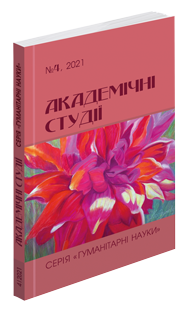Abstract
The article states that youth subculture and slang are closely related, as they arise from the necessity for young people to socialize and at the same time actively express themselves. Emphasis is placed on the fact that modern mass media reflect the specifics of the life of each generation, become a means of identification, differentiation of different youth groups and a form of self-expression. New lexical means are constantly appearing in the language of mass media, which allow to concisely and accurately convey the moods, experiences, thoughts, impressions and emotions of young people. It is stated that the language of the youth subculture is always extremely expressive, concise, informative, it is characterized by elements of colloquialism, sometimes rude and familiar color. These processes are especially relevant in the functioning of the lexemes of the following thematic groups. In order to influence the audience, the authors of the publications use the nominations of these thematic groups, which are actively used in modern society and understood by young readers. It was found that they are often used in publications on politics, economics, crime, elections, sports. Quite often with their help the authors of publications reproduce the color of the youth environment, describe the realities of today's youth, characterize and evaluate socio-political processes in Ukraine. It is established that the source of expression of modern journalism are numerous slang units that allow to convey positive or negative emotions, mental states, emphasize the grossly ironic tone of the texts. Relevant for the modern reader slang units allow to accurately and succinctly describe the phenomenon that is mentioned in the publications, violating the criteria of stylistic appropriateness, ethics and aesthetics of the Ukrainian language. The collected factual material confirms that the functioning of slang units in the media space indicates a high degree of stratification of modern society and its instability. In addition, in modern journalism we see a decline in language and general culture, literacy, replacement of true values by standard foreign models.
References
Боднар Р. В. Соціолект підлітків як субкультура сучасного лінгвосоціуму (на матеріалі англійської мови 90-х років ХХ – початку XXI століття) : автореф. дис. … на здобуття наук. ступ. канд. філол. наук : 10.02.04 «Германські мови». Київ, 2007. 20 с.
Бондаренко К. Л. Лінгвокультурні особливості українського та англійського сленгу : автореф. дис. … на здобуття канд. філол. наук : 10.02.17 «Порівняльно-історичне і типологічне мовознавство». Донецьк, 2007. 19 с.
Грабовий П. М. Когнітивні параметри українського молодіжного сленгу : автореф. дис. … на здобуття наук. ступеня канд. філол. наук : 10.02.01 «Українська мова». Київ, 2010. 18 с.
Кондратюк Т. М. Словник сучасного українського сленгу. Харків : Фоліо, 2006. 350 с.
Мартос С. А. Молодіжний сленг у мовленнєвій структурі м. Херсона : автореф. дис. … на здобуття наук. ступеня канд. філол. наук : 10.02.01 «Українська мова». Луганськ, 2006. 20 с.
Щур І. І. Українськомовний комп’ютерний сленг : формування і функціонування : автореф. дис. … на здобуття наук. ступеня канд. філол. наук : 10.02.01 «Українська мова». Київ, 2006. 20 с.

